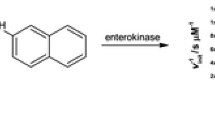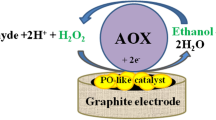Abstract
A new method for the determination of protease activities is described. In this large family, trypsin is used as a protease model that cleaves the enthyl or methyl ester of artificial substrates producing ethanol or methanol. Alcohol is detected using an alcohol oxidase enzyme electrode. The H2O2 production that occurs is measured amperometrically. At 30°C, in a 0.1M phosphate buffer, pH 7.5, the enzyme electrode response for ethanol was calibrated at 3.10−6–3.10−3 M and for methanol from 3.10−7 to 4.10−4 M in the cell measurement. Trypsin levels as determined by the proposed method and by a conventional spectrophotometric method are in good agreement when using the same measurement conditions. A detection limit of 10 U·L−1 and a linear calibration curve of 10–100,000 U·L−1 in the sample were obtained. Measuring time for the required trypsin solution concentration was from 4 min (for the most dilute samples) to 1 min (for the most concentrate samples). In a typical experiment, protease measurements did not inactivate the alcohol oxidase on the probe, nor did a more classical use for alcohol detection. The procedure developed could permit any protease estimation on the condition that they hydrolyze ester bonds from synthetic substrate.
Similar content being viewed by others
References
Clark, L. C., Jr. and Lyons, C. (1962),Ann. NY Acad. Sci. 102, 29–45.
Guilbault, G. G. (1984),Analytical Uses of Enzymes, Marcel Dekker, New York.
Turner, A. P. F., Karube, I., and Wilson, G. S. (1987),Biosensors, Fundamentals and Applications, Oxford University Press, New York.
Romette, J. L. and Thomas, D. (1988), inMethods in Enzymology vol. 137, Mosback, K. ed., Academic, San Diego, CA, pp. 44–61.
Coughland, M. P., Kierstan, M. P. J., Border, P. M., and Turner, A. P. F. (1988),J. Microb. Meth. 8, 1–50.
Schmid, R. D. and Scheller, F. (1989),Biosensors, Applications in Medicine, Environmental Protection and Process Control. GBF Monographs, vol. 13, VCH, New York.
Hall, E. A. H. (1990),Biosensors, Open University Press, Buckingham.
Buck, R. P., Hatfield, W. E., Umana, M., and Bowden, E. (1990), inBiosensor Technology, Fundamentals and Applications, Marcel Dekker, New York.
Coulet, P. R., Bardeletti, G., and Sechaud, F. (1991), inBioinstrumentation and Biosensors, Wise, D. L., ed., Marcel Dekker New York, pp. 755–795.
Guilbault, G. G., Suleiman, A. A., Fatibello-Filho, O., and Nabirahni, M. A., (1991), inBioinstrumentation and Biosensors, Wise, D. L., ed., Marcel Dekker, New York, pp. 659–692.
Blum, L. J. and Coulet, P. R. (1991),Biosensor Principles and Applications, Marcel Dekker, New York.
Nanjo, M. and Gulbault, G. G. (1975),Anal. Chim. Acta. 75, 169–180.
Belgith, H., Romette, J. L., and Thomas, D. (1987),Biotech. Bioeng. 30, 1001–1005.
Kitagawa, Y., Ameyama, M., Nakashima, K., Tamiya, E., and Karube, I. (1987),Analyst 112, 1747–1749.
Hikuma, M., Kubo, T., Yasuda, T., Karube, I., and Susuki, S. (1979),Biotech. Bioeng. 21, 1845–1853.
Blaedel, W. J. and Engstrom, R. C. (1980),Anal. Chem. 52, 1691–1697.
Mascini, M., Memoli, A., and Olana, F. (1989),Enzyme Microb. Technol. 11, 297–301.
Karube, I. and SangMok Chang, M. E. (1991), inBiosensor Principles and Applications, Blum, L. J. and Coulet, P. R., eds., Marcel Dekker, New York, pp. 267–301.
Albery, W. J., Bartlett, P. N., Cass, A. E. G., and Sim, K. W. (1987),J. Electroanal. Chem. 218, 127–134.
Sim, K. W. (1990),Biosensors Bioelectron. 5, 311–325.
Kulys, J. and Schmid, R. D. (1991),Biosensor Bioelectronics 6, 43–48.
Guilbault, G. G., Danielson, B., Mandenius, C. F., and Mosback, K. (1983).Anal. Chem. 55, 1582–1585.
Zhao, J. and Buck, R. P. (1991),Biosensors Bioelectronics 6, 681–687.
Smith, V. J., Green, R. A., and Hopkins, T. R. (1989),J. Assoc. Off. Anal. Chem. 72, 30–33.
Peguin, S., Coulet, P. R., and Bardeletti, G. (1989),Anal. Chim. Acta. 222, 83–93.
Bardeletti, G., Sechaud, F., and Coulet, P. R. (1991), inBiosensor Principles and Applications, Blum, L. J. and Coulet, P. R., eds., Marcel Dekker, New York, pp. 7–45.
Scheller, T. and Schubert, F. (1992), inBiosensors, Elsevier, Amsterdam, pp. 307–310.
Godfrey, T. and Reichelt, J. (1983),Industrial Enzymology. The Application of Enzymes in Industry, The Nature Press.
Bardeletti, G., Sechaud, F., and Coulet, P. R. (1986),Anal. Chim. Acta. 187, 47–54.
Rick, W. (1981), inMethods of Enzymatic Analysis, vol. 2, VCH Verlagsgesellschadt mbH, Weinheim, pp. 1013–1024.
Monsan, P. and Combes, D. (1988), inMethods in Enzymology, vol. 137, Mosback, K. ed., Academic, San Diego, CA, pp. 584–598.
Sahm, H. and Wagner, F. (1973),Eur. J. Biochem. 36, 250–256.
Kato, N., Omori, Y., Tani, Y., and Gata, K. (1976),Eur. J. Biochem. 64, 341–350.
Danielson, B. (1991), inBiosensor Principles and Applications, Blum, L. J., and Coulet, P. R., eds., Marcel Dekker, New York, pp. 83–105.
Dixon, M. and Webb, E. C. (1979),Enzymes, 3rd ed., Academic, New York, pp. 261–262.
Sarath, G., De la Motte, R., and Wagner, F. W. (1989), inProteolytic Enzymes—a Practical Approach, Beynon, B. J. and Bond, J. S., eds, IRL Press, Oxford, pp. 25–55.
Bergmeyer, H. U., Bernt, E., Grossl, M., and Michal, G. (1981), inMethods of Enzymatic Analysis, VCH Verlasgesellschadt mbH, Weinheim, pp. 308–317.
Author information
Authors and Affiliations
Rights and permissions
About this article
Cite this article
Bardeletti, G., Carillon, C. Protease determination using an optimized alcohol enzyme electrode. Appl Biochem Biotechnol 43, 177–188 (1993). https://doi.org/10.1007/BF02916451
Received:
Accepted:
Issue Date:
DOI: https://doi.org/10.1007/BF02916451




